Bearing Fault Diagnosis Using an Extended Variable Structure Feedback Linearization Observer
Abstract
:1. Introduction
2. Problem Statement and Diagnosis Objective
3. Proposed Method
3.1. Proportional-Integral Observer (PIO)
3.2. Variable Structure Extended Feedback Linearization Observer (FLO)
| Algorithm 1 Extended variable structure feedback linearization observer for fault diagnosis of the bearing |
| 1: Bearing vibration modelling (8) 2: Run the feedback linearization observer (13), (14) 3: Run the observer evaluator based on the VSO method (16), (18) 4: Run the residual generator (19) 5: Run the threshold value based on variable structure technique (27) 6: Run the decision logic and residual bank for fault detection and diagnosis (28) |
4. Results and Analysis
4.1. Bearing Data
4.2. Performance Measurement
5. Conclusions
Author Contributions
Funding
Conflicts of Interest
Nomenclature
| Force vector | Mass matrix | ||
| Stiffness matrix | Damping matrix | ||
| Nonlinear bearing parameter vector | Various types of fault | ||
| Uncertain and unknown parameter | Unknown modeling for mass matrix | ||
| Unknown modeling for stiffness matrix | Unknown modeling for damping matrix | ||
| Normal threshold value | System’s input | ||
| State of REB | Output coefficient | ||
| Ball fault | Inner fault | ||
| Outer fault | System’s uncertainty and unknown parameter | ||
| System’s output | System state estimation | ||
| Measured output estimation | Control input | ||
| Uncertainty estimation and disturbance | Faults estimation | ||
| output, proportional, and integral coefficients, respectively | Laguerre poles | ||
| Null matrices | States and output coefficients | ||
| Coefficients | Variable structure variable | ||
| Threshold value for normal, ball, and inner | (normal, ball, and inner) threshold values | ||
| (ball, inner, and outer) failures | , | Positive constants |
References
- Gao, Z.; Cecati, C.; Ding, S.X. A survey of fault diagnosis and fault-tolerant techniques—Part I: Fault diagnosis with model-based and signal-based approaches. IEEE Trans. Ind. Electron. 2015, 62, 3757–3767. [Google Scholar] [CrossRef]
- Adams, M.L. Analysis of Rolling Element Bearing Faults in Rotating Machinery: Experiments, Modeling, Fault Detection and Diagnosis. Ph.D. Thesis, Case Western Reserve University, Cleveland, OH, USA, 2001. [Google Scholar]
- Afshari, N.; Loparo, K.A. A model-based technique for the fault detection of rolling element bearings using detection filter design and sliding mode technique. In Proceedings of the 37th IEEE Conference on Decision and Control, Tampa, FL, USA, 18 December 1998; Volume 3, pp. 2593–2598. [Google Scholar]
- Agrawal, S.; Mohanty, S.R.; Agarwal, V. Bearing fault detection using Hilbert and high frequency resolution techniques. IETE J. Res. 2015, 61, 99–108. [Google Scholar] [CrossRef]
- Kang, M.; Kim, J.; Kim, J.M.; Tan, A.C.; Kim, E.Y.; Choi, B.K. Reliable fault diagnosis for low-speed bearings using individually trained support vector machines with kernel discriminative feature analysis. IEEE Trans. Power Electron. 2015, 30, 2786–2797. [Google Scholar] [CrossRef]
- Li, Z.; Jiang, Y.; Guo, Q.; Hu, C.; Peng, Z. Multi-dimensional variational mode decomposition for bearing-crack detection in wind turbines with large driving-speed variations. Renew. Energy 2018, 116, 55–73. [Google Scholar] [CrossRef]
- Glowacz, A. Fault diagnosis of single-phase induction motor based on acoustic signals. Mech. Syst. Signal Process. 2019, 117, 65–80. [Google Scholar] [CrossRef]
- Zhang, C.; Li, Z.; Chen, S.; Wang, J.; Zhang, X. Optimised ensemble empirical mode decomposition with optimised noise parameters and its application to rolling element bearing fault diagnosis. Insight-Non-Destr. Test. Cond. Monit. 2016, 58, 494–501. [Google Scholar] [CrossRef]
- Glowacz, A. Acoustic-Based Fault Diagnosis of Commutator Motor. Electronics 2018, 7, 299. [Google Scholar] [CrossRef]
- Caesarendra, W.; Tjahjowidodo, T. A review of feature extraction methods in vibration-based condition monitoring and its application for degradation trend estimation of low-speed slew bearing. Machines 2017, 5, 21. [Google Scholar] [CrossRef]
- Wang, Z.; Huang, Z.; Song, C.; Zhang, H. Multiscale adaptive fault diagnosis based on signal symmetry reconstitution preprocessing for microgrid inverter under changing load condition. IEEE Trans. Smart Grid 2018, 9, 797–806. [Google Scholar] [CrossRef]
- Wang, C.-S.; Sha, C.-Y.; Su, M.; Hu, Y.-K. An algorithm to remove noise from locomotive bearing vibration signal based on self-adaptive EEMD filter. J. Central South. Univ. 2017, 24, 478–488. [Google Scholar] [CrossRef]
- Hong, W.; Jing, X. Vibration signal–based fault diagnosis in complex structures: A beam-like structure approach. Struct. Health Monit. 2018, 17, 472–493. [Google Scholar]
- Liu, Z.; Liu, T.; Han, J.; Bu, S.; Tang, X.; Pecht, M. Signal model-based fault coding for diagnostics and prognostics of analog electronic circuits. IEEE Trans. Ind. Electron. 2017, 64, 605–614. [Google Scholar] [CrossRef]
- Tahir, M.M.; Khan, A.Q.; Iqbal, N.; Hussain, A.; Badshah, S. Enhancing fault classification accuracy of ball bearing using central tendency based time domain features. IEEE Access 2017, 5, 72–83. [Google Scholar] [CrossRef]
- Liu, R.; Yang, B.; Zio, E.; Chen, X. Artificial intelligence for fault diagnosis of rotating machinery: A review. Mech. Syst. Signal Process. 2018, 108, 33–47. [Google Scholar] [CrossRef]
- Sohaib, M.; Kim, J.M. Reliable Fault Diagnosis of Rotary Machine Bearings Using a Stacked Sparse Autoencoder-Based Deep Neural Network. Shock. Vib. 2018, 2018, 2919637. [Google Scholar] [CrossRef]
- Cai, B.; Liu, Y.; Fan, Q.; Zhang, Y.; Liu, Z.; Yu, S.; Ji, R. Multi-source information fusion based fault diagnosis of ground-source heat pump using Bayesian network. Appl. Energy 2014, 114, 1–9. [Google Scholar] [CrossRef]
- Cai, B.; Huang, L.; Xie, M. Bayesian networks in fault diagnosis. IEEE Trans. Ind. Inform. 2017, 13, 2227–2240. [Google Scholar] [CrossRef]
- Cai, B.; Zhao, Y.; Liu, H.; Xie, M. A data-driven fault diagnosis methodology in three-phase inverters for PMSM drive systems. IEEE Trans. Power Electron. 2017, 32, 5590–5600. [Google Scholar] [CrossRef]
- Cai, B.; Kong, X.; Liu, Y.; Lin, J.; Yuan, X.; Xu, H.; Ji, R. Application of Bayesian Networks in Reliability Evaluation. IEEE Trans. Ind. Inform. 2018. [Google Scholar] [CrossRef]
- Stavrou, D.; Eliades, D.G.; Panayiotou, C.G.; Polycarpou, M.M. Fault detection for service mobile robots using model-based method. Auton. Robots 2016, 40, 383–394. [Google Scholar] [CrossRef]
- López-Estrada, F.R.; Ponsart, J.C.; Theilliol, D.; Zhang, Y.; Astorga-Zaragoza, C.M. LPV model-based tracking control and robust sensor fault diagnosis for a quadrotor UAV. J. Intell. Robot. Syst. 2016, 84, 163–177. [Google Scholar] [CrossRef]
- Van, M.; Franciosa, P.; Ceglarek, D. Fault diagnosis and fault-tolerant control of uncertain robot manipulators using high-order sliding mode. Math. Probl. Eng. 2016, 2016, 7926280. [Google Scholar] [CrossRef]
- Xue, X.; Zhou, J. A hybrid fault diagnosis approach based on mixed-domain state features for rotating machinery. ISA Trans. 2017, 66, 284–295. [Google Scholar] [CrossRef] [PubMed]
- Khalastchi, E.; Kalech, M.; Rokach, L. A hybrid approach for improving unsupervised fault detection for robotic systems. Expert Syst. Appl. 2017, 81, 372–383. [Google Scholar] [CrossRef]
- Cecati, C. A survey of fault diagnosis and fault-tolerant techniques—Part II: Fault diagnosis with knowledge-based and hybrid/active approaches. IEEE Trans. Ind. Electron. 2015, 62, 3768–3774. [Google Scholar]
- Islam, M.M.; Kim, J.; Khan, S.A.; Kim, J.M. Reliable bearing fault diagnosis using Bayesian inference-based multi-class support vector machines. J. Acoust. Soc. Am. 2017, 141, 89–95. [Google Scholar] [CrossRef] [PubMed]
- Avendaño-Valencia, L.D.; Spilios, D.F. Damage/fault diagnosis in an operating wind turbine under uncertainty via a vibration response Gaussian mixture random coefficient model based framework. Mech. Syst. Signal Process. 2017, 91, 326–353. [Google Scholar] [CrossRef]
- Forrai, A. System Identification and Fault Diagnosis of an Electromagnetic Actuator. IEEE Trans. Control Syst. Technol. 2017, 25, 1028–1035. [Google Scholar] [CrossRef]
- N’Doye, I.; Khaled, N.S.; Taous-Meriem, K.-K. Robust fractional-order proportional-integral observer for synchronization of chaotic fractional-order systems. IEEE/CAA J. Autom. Sin. 2018. [Google Scholar] [CrossRef]
- Najeh, T.; Njima, C.B.; Garna, T.; Ragot, J. Input fault detection and estimation using PI observer based on the ARX-Laguerre model. Int. J. Adv. Manuf. Technol. 2017, 90, 1317–1336. [Google Scholar] [CrossRef]
- Patrick, K.; Pöschke, F.; Schulte, H. Fault estimation and fault-tolerant control of the FAST NREL 5-MW reference wind turbine using a proportional multi-integral observer. Int. J. Adapt. Control Signal Process. 2018, 32, 568–585. [Google Scholar]
- Ouhib, L. State and unknown inputs estimation for Takagi-Sugeno systems with immeasurable premise variables: Proportional Multiple Integral observer design. Math. Comput. Simul. 2018. [Google Scholar] [CrossRef]
- Gao, Z.; Ding, S.X.; Ma, Y. Robust fault estimation approach and its application in vehicle lateral dynamic systems. Optim. Control Appl. Methods 2007, 28, 143–156. [Google Scholar] [CrossRef]
- Du, D. Fault detection for discrete-time linear systems based on descriptor observer approach. Appl. Math. Comput. 2017, 293, 575–585. [Google Scholar] [CrossRef]
- Alaei, H.K.; Alireza, Y. Robust Output Disturbance, Actuator and Sensor Faults Reconstruction Using H∞ Sliding Mode Descriptor Observer for Uncertain Nonlinear Boiler System. Int. J. Control Autom. Syst. 2018, 16, 1271–1281. [Google Scholar] [CrossRef]
- Abbaspour, A.; Aboutalebi, P.; Yen, K.K.; Sargolzaei, A. Neural adaptive observer-based sensor and actuator fault detection in nonlinear systems: Application in UAV. ISA Trans. 2017, 67, 317–329. [Google Scholar] [CrossRef] [PubMed]
- Wang, F.; Davari, S.A.; Chen, Z.; Zhang, Z.; Khaburi, D.A.; Rodríguez, J.; Kennel, R. Finite control set model predictive torque control of induction machine with a robust adaptive observer. IEEE Trans. Ind. Electron. 2017, 64, 2631–2641. [Google Scholar] [CrossRef]
- Gholizadeh, M.; Salmasi, F.R. Estimation of state of charge, unknown nonlinearities, and state of health of a lithium-ion battery based on a comprehensive unobservable model. IEEE Trans. Ind. Electron. 2014, 61, 1335–1344. [Google Scholar] [CrossRef]
- Liu, J.; Vazquez, S.; Wu, L.; Marquez, A.; Gao, H.; Franquelo, L.G. Extended state observer-based sliding-mode control for three-phase power converters. IEEE Trans. Ind. Electron. 2017, 64, 22–31. [Google Scholar] [CrossRef]
- Xiao, B.; Yin, S.; Gao, H. Reconfigurable tolerant control of uncertain mechanical systems with actuator faults: A sliding mode observer-based approach. IEEE Trans. Control Syst. Technol. 2018, 26, 1249–1258. [Google Scholar] [CrossRef]
- Alwi, H.; Edwards, C. Robust fault reconstruction for linear parameter varying systems using sliding mode observers. Int. J. Robust Nonlinear Control 2014, 24, 1947–1968. [Google Scholar] [CrossRef]
- Han, X.; Fridman, E.; Spurgeon, S.K. Sampled-data sliding mode observer for robust fault reconstruction: A time-delay approach. J. Frankl. Inst. 2014, 351, 2125–2142. [Google Scholar] [CrossRef] [Green Version]
- Alonge, F.; Cirrincione, M.; Pucci, M.; Sferlazza, A. Input–output feedback linearization control with on-line MRAS-based inductor resistance estimation of linear induction motors including the dynamic end effects. IEEE Trans. Ind. Appl. 2016, 52, 254–266. [Google Scholar] [CrossRef]
- Seyedalipour, S.S.; Hosseini, M.S.; Gharehpetian, G.B. Grid interconnection of distributed generation units at distribution level using feedback linearization technique. In Proceedings of the 2016 21st Conference on Electrical Power Distribution Networks Conference (EPDC), Karaj, Iran, 26–27 April 2016; pp. 239–244. [Google Scholar]
- Piltan, F.; Kim, J.M. Bearing fault diagnosis by a robust higher-order super-twisting sliding mode observer. Sensors 2018, 18, 1128. [Google Scholar] [CrossRef] [PubMed]
- Piltan, F.; Sohaib, M.; Kim, J.M. Fault Diagnosis of a Robot Manipulator Based on an ARX-Laguerre Fuzzy PID Observer. In International Conference on Robot Intelligence Technology and Applications; Springer: Cham, Switzerland, 2007; pp. 393–407. [Google Scholar]
- Smith, W.A.; Randall, R.B. Rolling element bearing diagnostics using the Case Western Reserve University data: A benchmark study. Mech. Syst. Signal Process. 2015, 64, 100–131. [Google Scholar] [CrossRef]
- Mishra, C.; Samantaray, A.K.; Chakraborty, G. Ball bearing defect models: A study of simulated and experimental fault signatures. J. Sound Vib. 2017, 400, 86–112. [Google Scholar] [CrossRef]
- Moreno, J.A.; Osorio, M. A Lyapunov approach to second-order sliding mode controllers and observers. In Proceedings of the 47th IEEE Conference on Decision and Control, Cancun, Mexico, 9–11 December 2008. [Google Scholar]


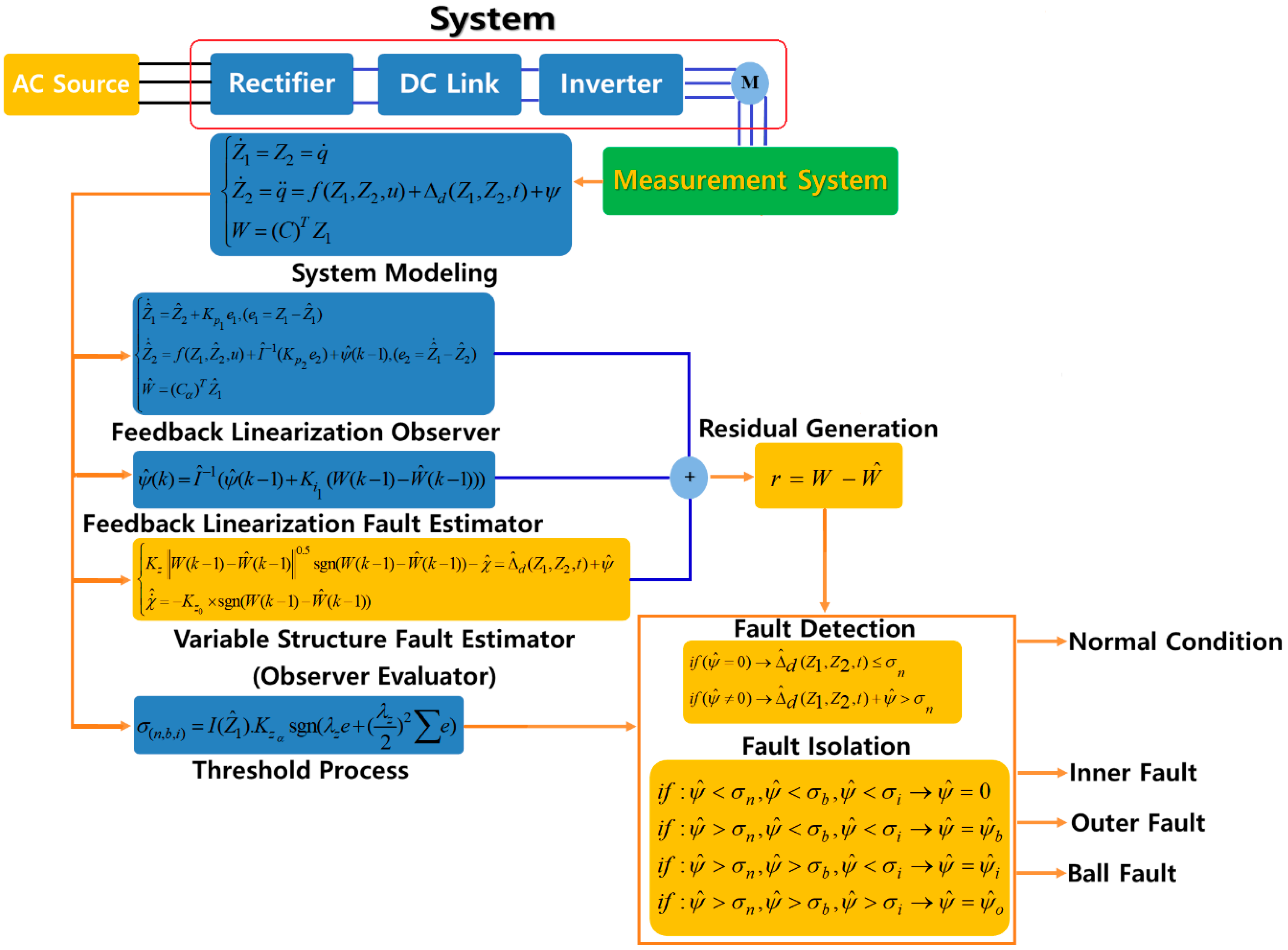

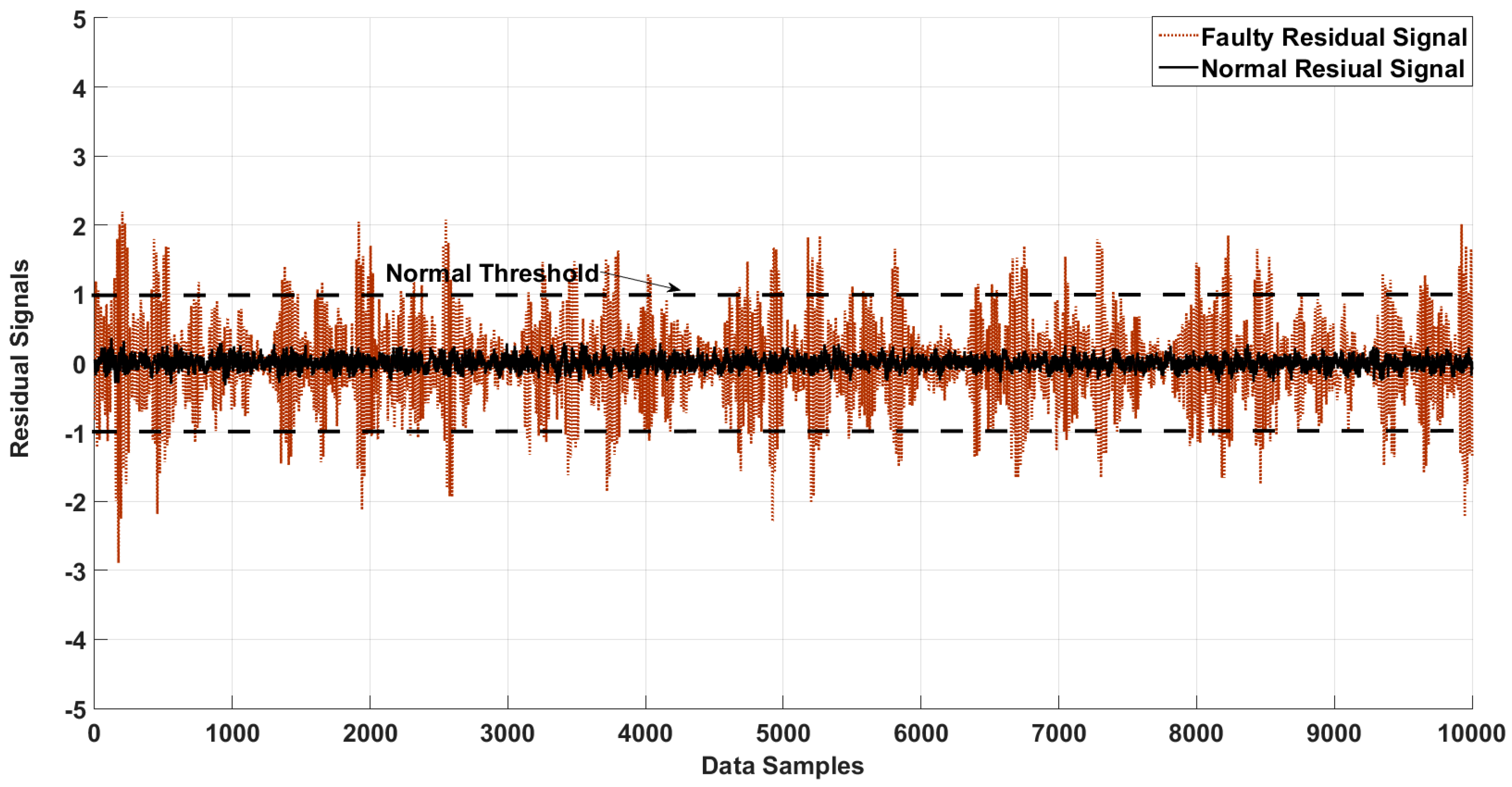
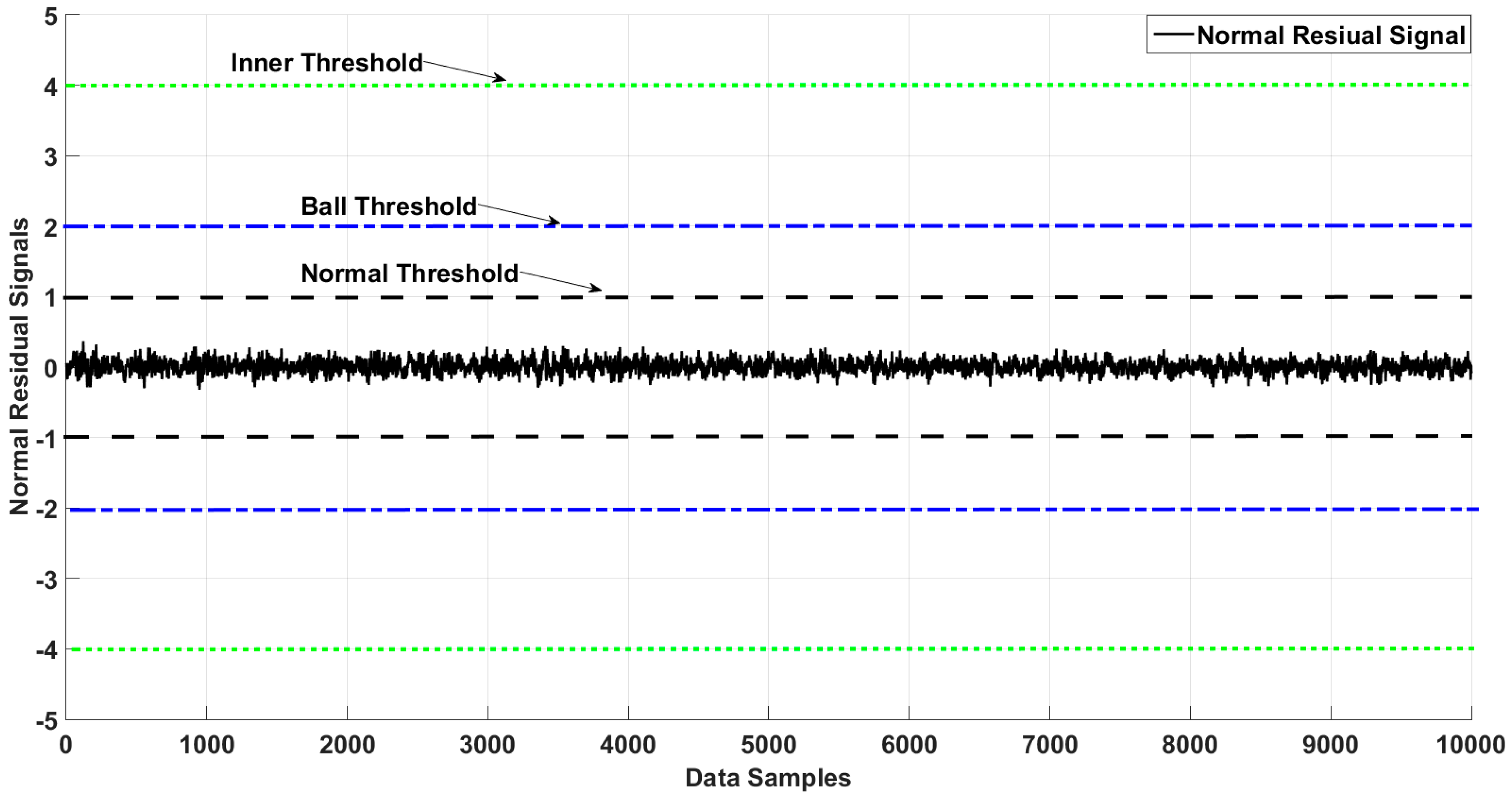
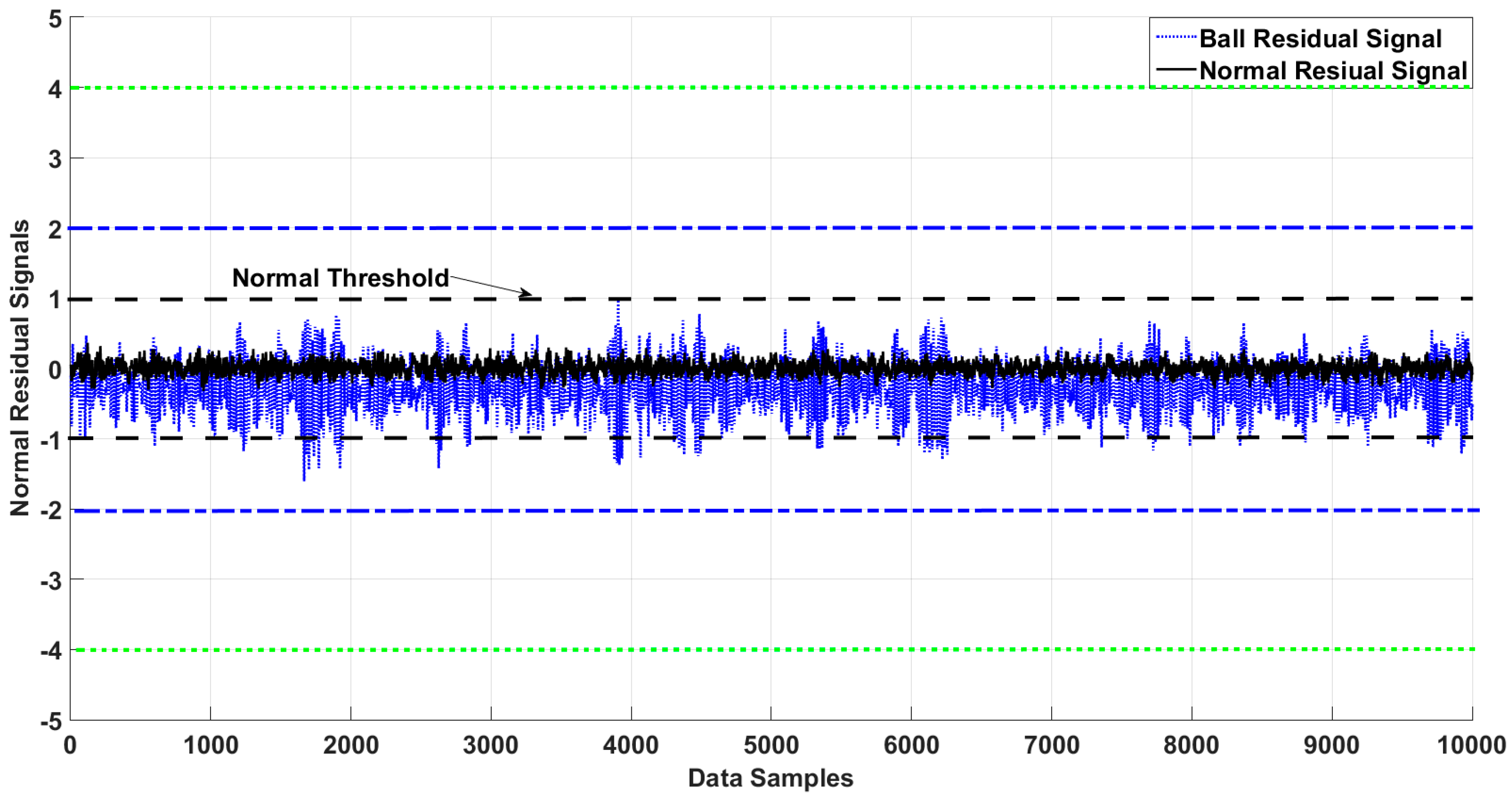
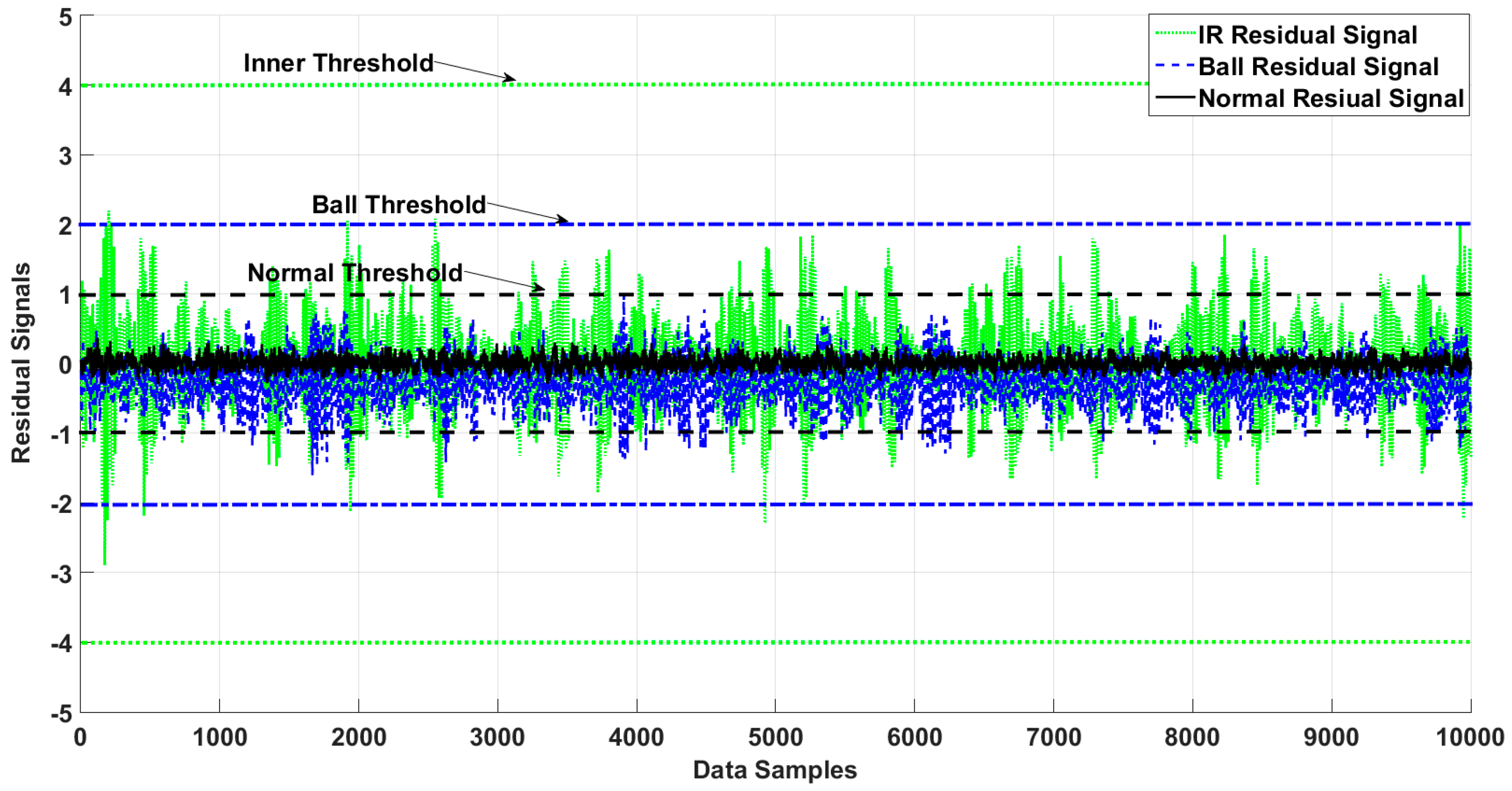

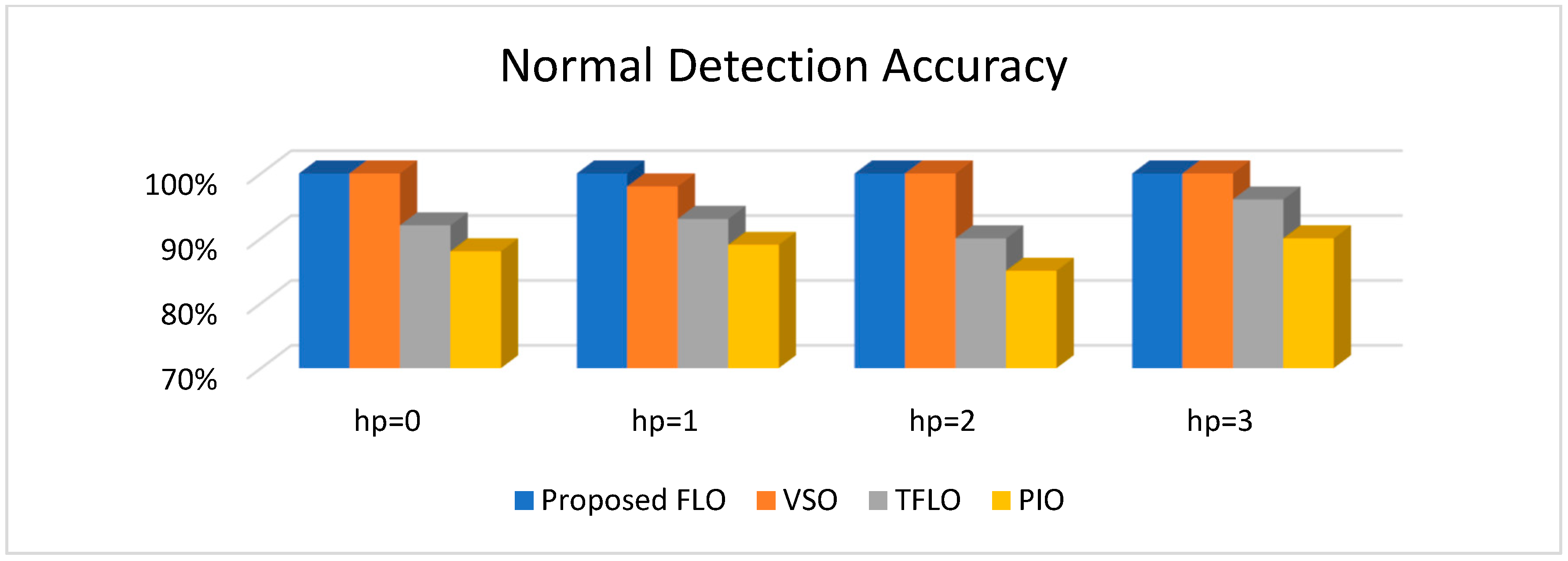

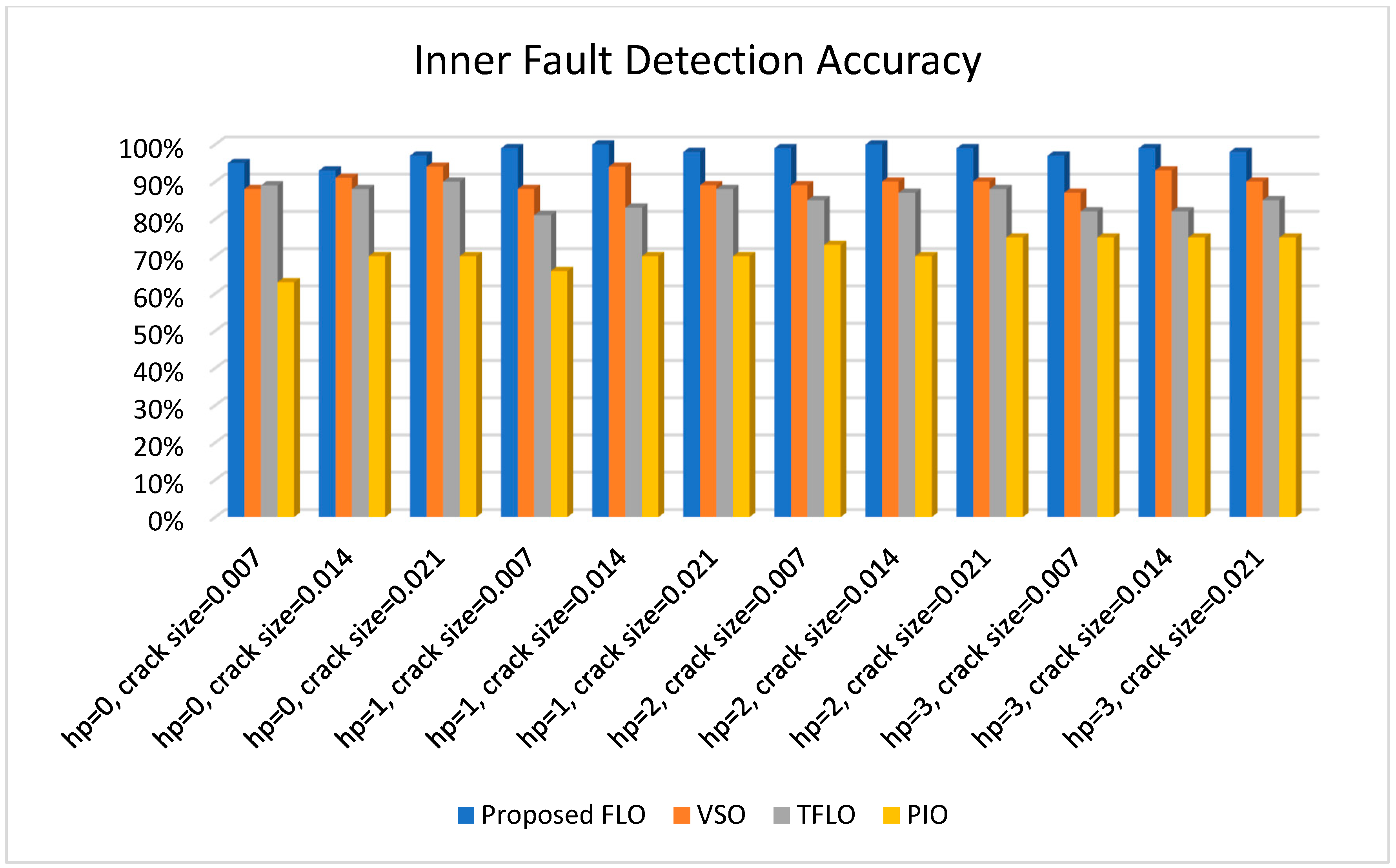
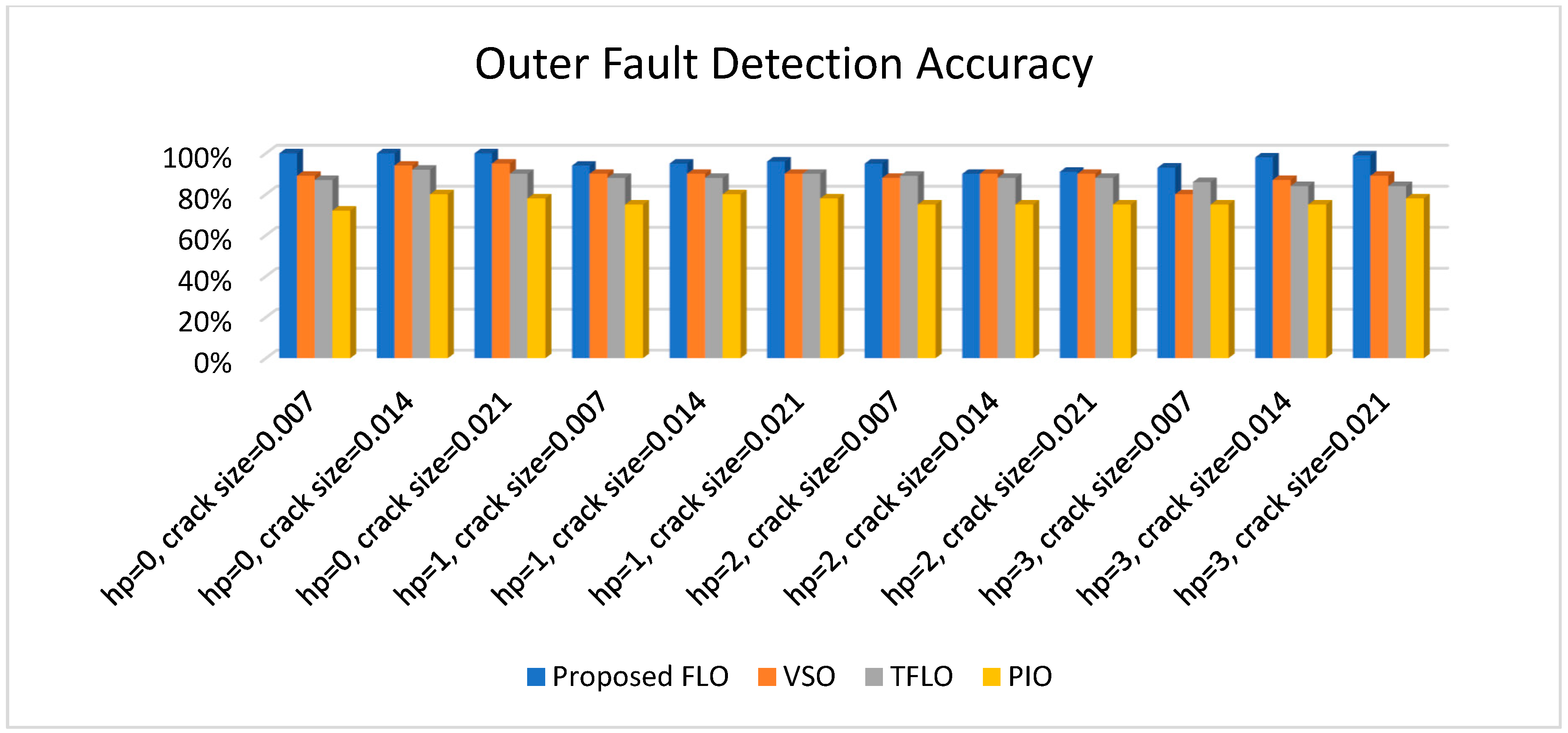
| Parameters | Value |
|---|---|
| Number of balls | |
| Stiffness of ball | |
| Mass of outer (Kg) | |
| Stiffness of outer | |
| Mass of shaft (Kg) | |
| Stiffness of Shaft | |
| Damping | |
| Ball diameter | |
| Pitch diameter | |
| Defect size | |
| Defect depth |
| Dataset f = 12 kHz | Fault Types | Motor Load (hp) | Motor Speed (rpm) | Fault Crack Size (in) | Number of Samples |
|---|---|---|---|---|---|
| Dataset 1 | Normal states | 0 | 1797 | 0.007, 0.014, and 0.021 | 1395 |
| IR fault states | 0 | 1797 | |||
| OR fault states | 0 | 1797 | |||
| Ball fault states | 0 | 1797 | |||
| Dataset 2 | Normal states | 1 | 1772 | 0.007, 0.014, and 0.021 | 1395 |
| IR fault states | 1 | 1772 | |||
| OR fault states | 1 | 1772 | |||
| Ball fault states | 1 | 1772 | |||
| Dataset 3 | Normal states | 2 | 1750 | 0.007, 0.014, and 0.021 | 1395 |
| IR fault states | 2 | 1750 | |||
| OR fault states | 2 | 1750 | |||
| Ball fault states | 2 | 1750 | |||
| Dataset 4 | Normal states | 3 | 1730 | 0.007, 0.014, and 0.021 | 1395 |
| IR fault states | 3 | 1730 | |||
| OR fault states | 3 | 1730 | |||
| Ball fault states | 3 | 1730 |
| Algorithms | Proposed FLO | PIO | TFLO | VSO | ||||||||||||
|---|---|---|---|---|---|---|---|---|---|---|---|---|---|---|---|---|
| Motor Speed (rpm) | 1730 | 1750 | 1772 | 1797 | 1730 | 1750 | 1772 | 1797 | 1730 | 1750 | 1772 | 1797 | 1730 | 1750 | 1772 | 1797 |
| Normal state | 100% | 100% | 100% | 100% | 90% | 85% | 89% | 88% | 96% | 90% | 93% | 92% | 100% | 100% | 98% | 100% |
| IR fault | 97% | 99% | 99% | 99% | 75% | 73% | 66% | 63% | 82% | 85% | 81% | 89% | 87% | 89% | 88% | 88% |
| OR fault | 93% | 95% | 94% | 100% | 75% | 75% | 75% | 87% | 86% | 89% | 88% | 87% | 80% | 88% | 90% | 89% |
| Ball fault | 95% | 95% | 97% | 100% | 78% | 78% | 81% | 84% | 86% | 89% | 86% | 89% | 85% | 88% | 90% | 89% |
| Average | 96.2% | 97.25% | 97.5% | 99.7% | 79.5% | 77.7% | 77.8% | 80.5% | 87.5% | 88.2% | 87% | 89.2% | 88% | 91.25% | 91.5% | 91.5% |
| Algorithms | Proposed FLO | PIO | TFLO | VSO | ||||||||||||
|---|---|---|---|---|---|---|---|---|---|---|---|---|---|---|---|---|
| Motor Speed (rpm) | 1730 | 1750 | 1772 | 1797 | 1730 | 1750 | 1772 | 1797 | 1730 | 1750 | 1772 | 1797 | 1730 | 1750 | 1772 | 1797 |
| Normal state | 100% | 100% | 100% | 100% | 90% | 85% | 89% | 88% | 96% | 90% | 93% | 92% | 100% | 100% | 98% | 100% |
| IR fault | 99% | 100% | 100% | 96% | 75% | 70% | 70% | 88% | 82% | 87% | 83% | 88% | 93% | 90% | 94% | 91% |
| OR fault | 98% | 94% | 95% | 100% | 75% | 75% | 80% | 80% | 84% | 88% | 88% | 92% | 87% | 90% | 90% | 94% |
| Ball fault | 94% | 94% | 95% | 100% | 75% | 81% | 81% | 74% | 86% | 87% | 92% | 92% | 87% | 90% | 88% | 91% |
| Average | 97.7% | 97% | 97.5% | 99% | 78.7% | 77.7% | 80% | 82.5% | 86% | 88% | 89% | 91% | 91.7% | 92.5% | 92.5% | 94% |
| Algorithms | Proposed FLO | PIO | TFLO | VSO | ||||||||||||
|---|---|---|---|---|---|---|---|---|---|---|---|---|---|---|---|---|
| Motor Speed (rpm) | 1730 | 1750 | 1772 | 1797 | 1730 | 1750 | 1772 | 1797 | 1730 | 1750 | 1772 | 1797 | 1730 | 1750 | 1772 | 1797 |
| Normal state | 100% | 100% | 100% | 100% | 90% | 85% | 89% | 88% | 96% | 90% | 93% | 92% | 100% | 100% | 98% | 100% |
| IR fault | 98% | 99% | 98% | 97% | 75% | 75% | 70% | 70% | 85% | 88% | 88% | 90% | 90% | 90% | 89% | 94% |
| OR fault | 99% | 96% | 97% | 100% | 78% | 75% | 78% | 78% | 84% | 88% | 90% | 90% | 89% | 90% | 90% | 95% |
| Ball fault | 94% | 97% | 98% | 100% | 81% | 81% | 84% | 78% | 87% | 88% | 90% | 91% | 87% | 90% | 92% | 92% |
| Average | 97.7% | 98% | 98.2% | 99.2% | 81% | 79% | 80.2% | 78.5% | 88% | 88.5% | 90.2% | 90.7% | 91.5% | 92.5% | 92.2% | 95.2% |
© 2018 by the authors. Licensee MDPI, Basel, Switzerland. This article is an open access article distributed under the terms and conditions of the Creative Commons Attribution (CC BY) license (http://creativecommons.org/licenses/by/4.0/).
Share and Cite
Piltan, F.; Kim, J.-M. Bearing Fault Diagnosis Using an Extended Variable Structure Feedback Linearization Observer. Sensors 2018, 18, 4359. https://doi.org/10.3390/s18124359
Piltan F, Kim J-M. Bearing Fault Diagnosis Using an Extended Variable Structure Feedback Linearization Observer. Sensors. 2018; 18(12):4359. https://doi.org/10.3390/s18124359
Chicago/Turabian StylePiltan, Farzin, and Jong-Myon Kim. 2018. "Bearing Fault Diagnosis Using an Extended Variable Structure Feedback Linearization Observer" Sensors 18, no. 12: 4359. https://doi.org/10.3390/s18124359
APA StylePiltan, F., & Kim, J.-M. (2018). Bearing Fault Diagnosis Using an Extended Variable Structure Feedback Linearization Observer. Sensors, 18(12), 4359. https://doi.org/10.3390/s18124359






